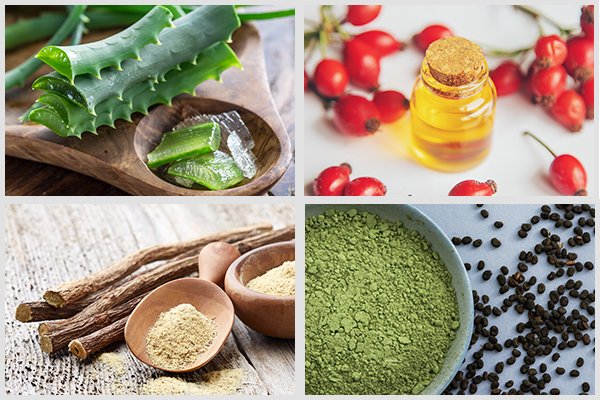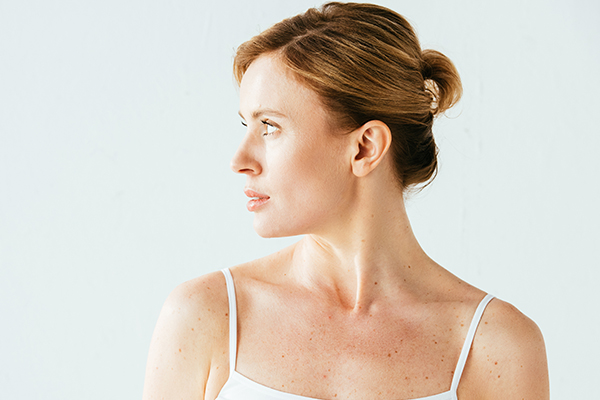In this article:
Spending a lot of time in the sun can be bad for your skin as long exposure to the sun can cause a rise in the production of cells called melanocytes, which are responsible for producing melanin. Melanin is the pigment found naturally in your body that gives your skin its color.

An increase in the amount of melanin in the skin can make your skin becoming darker in some places. These dark regions are called brown spots, age spots, dark spots, liver spots, or sun spots.
Dark spots usually occur on regions of the skin that remain exposed to the sun. These can include your face, neck, shoulders, and hands.
In addition to sun exposure, the following factors can also contribute to dark spots: (1)(2)(3)
- Age
- Genetics
- Stress
- Pregnancy
- Nutritional deficiencies
Dark spots normally do not cause any harm, but you may want to get rid of them if you find them unattractive.
Note: If the remedies you’re using and the treatments you’re following do not show any good results on your dark spots, you may want to seek professional help from a dermatologist. Dark spots can be challenging to deal with in some cases and thus require proper medical treatment. A dermatologist has the understanding and experience of combining therapies that deliver results.
Home Remedies for Brown Spots on the Skin
To lighten dark spots, you can try the following home treatments.
1. Use aloe vera on the affected area daily
The benefits of using aloe vera for your skin are nothing unknown. The use of aloe vera for skin care has been well-known for innumerable years.
Furthermore, research studies have demonstrated aloe vera’s powerful anti-inflammatory action, which helps fight skin issues. One such issue is hyperpigmentation or brown spots.
According to one study, aloe vera contains a chemical compound called aloesin, which is reliable for treating hyperpigmentation when used by itself or in combination with arbutin, applied four times every day for 15 days. (4)
Another study demonstrated that aloe vera in silicone gel base reduces hyperpigmentation significantly after 4 weeks of daily use. (5)
How to use aloe vera gel:
- Cleanse your face with a mild cleanser.
- Dry your skin with a soft and clean towel by dabbing instead of rubbing.
- Apply aloe vera gel to your face and to the affected area.
2. Use licorice root extract every day
When you notice distinct colored patches or dark spots that make your skin appear rough and poorly textured, you should know it’s nothing but hyperpigmentation.
Licorice extract has been studied to settle down this issue and make your skin much healthier. This is because licorice extract works by brightening your skin while giving you the smoothness you have always wished for. (6)
Spending a lot of time out in the sun can be dangerous for your skin. UV rays from the sun can damage the skin and cause an increase in melanin production, leading to hyperpigmentation and discolorations.
Glabridin, one of the phytochemicals present in licorice root, reduces and reverses dark spots and pigmentation from sun damage. (7) Another depigmenting agent called liquiritin is also found in licorice extract and works by disintegrating excess melanin. (8)
How to use licorice root extract:
The easiest way to use licorice root on your skin is to look for a good product such as a serum that contains licorice extract as its main ingredient. Then use that product following the instructions on the packaging.
3. Incorporate bakuchiol products in your skin care regimen
Bakuchiol formulations have been found to show improvements in skin pigmentation when used twice a day for 12 weeks. (9) This effect of bakuchiol can be attributed to its action of enhancing collagen production, which helps improve skin tone and texture.
Bakuchiol is very useful for people with hyperpigmentation, as shown by a research study that found that the use of 0.5% bakuchiol cream for 12 weeks reduced hyperpigmentation on the skin. (10)
How to use bakuchiol products:
- Apply bakuchiol products to clean and dry skin.
- Apply a moisturizer that suits your skin.
Bakuchiol products can be applied twice daily if your skin handles it well with no adverse effects.

4. Massage with rosehip oil
As the name suggests, rosehip oil is extracted from the rose plant (Rosa canina) and its varieties by pressing the fruits of the plant to extract the oil, which is very nourishing.
Rosehip oil is packed with fatty acids that are incredible for your skin. The essential fatty acids in the oil include omega 3, 6, and 9 fatty acids, also known as linoleic acid, alpha-linolenic acid, and oleic acid. (11)
If you have many dark spots or patches on your skin, rosehip oil, with time, may be helpful in lightening them and reducing the discoloration. This oil is also useful for reducing skin redness because of its anti-inflammatory action. (12)
How to use rosehip oil extract:
- Take out 2–3 drops of rosehip oil on your hands.
- Use the tip of your finger to dab the oil all over your face.
- Gently massage the oil in circular motions.
5. Use green tea paste on your skin
Green tea has been researched for its antioxidant and anti-inflammatory activities for a long time now. Green tea extracts contain many polyphenolic compounds that are great antioxidants such as epigallocatechin-3-gallate (ECGC).
In one study, green tea demonstrated good clinical activity in treating hyperpigmentation or melasma.
In another study, women suffering from melasma were treated with a cream containing 2% green tea extract. Results showed that skin lesions diminished in 60% of the green tea-treated patients. So, green tea may be helpful in controlling dark spots or sun spots on your skin. (4)
How to use green tea:
- Take the leaves from your tea bags and add warm water to them.
- Mix this aqueous extract of green tea with aloe vera gel.
- Apply this paste to the affected areas of your skin.
- Leave it on for 10–20 minutes and then rinse it off with water.
6. Use a vitamin C serum or cream
Vitamin C moves into the skin in the form of ascorbic acid and is great for skin hydration. It lets your skin hold moisture and reduces water loss. It repairs the skin barrier as well.
Moreover, vitamin C is very valuable in diminishing skin dullness or pigmentation, making you look young. It depresses the production of melanin, which is helpful in avoiding dark spots and hyperpigmentation. (13)
To prevent skin dullness or spots/pigmentation, take the vitamin C route. This is because it gives the skin a glowing finish. Research supports that hyperpigmentation and dark spots can be dealt with using vitamin C. (14)
How to use vitamin C:
The best way to bring vitamin C into your skin care regimen is in the form of vitamin C cream or serum. This can be applied to the skin. You can use vitamin C products twice a day topically.

7. Give turmeric a try
Turmeric (Curcuma longa) is commonly used in the Ayurvedic healthcare system. The active component of turmeric is curcumin, which is a polyphenol.
Studies have demonstrated that curcumin exhibits anti-inflammatory and anti-carcinogenic actions. Furthermore, topical use of turmeric extract may reduce the appearance of hyperpigmentation and fine lines.
So, your spice cabinet may be a good place to look in if you want to deal with dark spots as turmeric may just do the trick. (4)
How to use turmeric:
- Make a paste by mixing turmeric powder with milk.
- Apply the mixture to your skin and let it sit until it dries.
- Rinse it off with water.
8. Go for dairy products
Fermented dairy products, such as yogurt, are biological sources of probiotics that promote gastrointestinal health. Rising evidence indicates that the upkeep of the gastrointestinal tract microbiota can be useful for managing skin diseases.
Results from studies indicate an improvement in skin health with the use of fermented dairy, both via ingestion or topical use. Skin care experts and dermatologists also support the use of yogurt on the skin to fight off hyperpigmentation and dark spots. (15)
How to Prevent Brown Spots

According to dermatologists, you need to take proper precautionary measures to protect your skin from sun exposure, which is the leading cause of dark spots. Follow these measures:
- Apply sunscreen that has SPF 30 or higher.
- Wear a hat when you go out in the sun.
- Cover your skin as much as possible to protect it from sun rays.
Most-Asked Questions About Brown Spots
What age group is prone to pigmentation problems such as dark spots?
Issues arising from hyperpigmentation vary from person to person and are most commonly observed in the age ranges of 15–30 years and 40–54 years, irrespective of skin color and gender. (16)
When does hyperpigmentation or dark spots fade?

The American Academy of Dermatology states that the time it takes for dark spots to fade depends upon what’s causing them.
A spot that is only a little darker than your skin color generally fades away within 6–12 months. If the color is deep in your skin, it can take years to fade away.
How to prevent hyperpigmentation?
Protection from sun exposure is critical for the treatment of dark spots or lesions that are worsened by UV radiation and visible light.
Applying sunscreen with an SPF greater than 30 is advised. It is important to use it multiple times a day. You can also wear hats during outdoor work to protect yourself from UV radiation during peak hours. (16)
Final Word
Brown spots or hyperpigmentation on the skin are harmless but can be bothersome for some people. Fortunately, there are various remedies and at-home management options to diminish them.
Besides remedies, sun protection and preventive measures are of utmost importance to make sure these spots don’t trouble you. If the condition gets worse or is accompanied by other symptoms, it is highly recommended to seek professional help.
 Continue ReadingBrown Spots on Skin: Causes, Risk Factors, and Standard Treatment
Continue ReadingBrown Spots on Skin: Causes, Risk Factors, and Standard Treatment
- Was this article helpful?
- YES, THANKS!NOT REALLY


